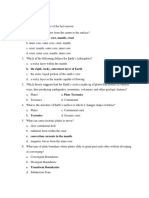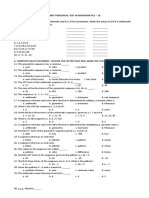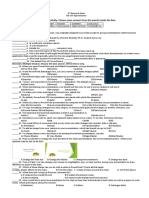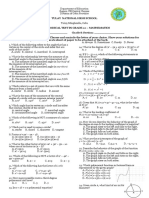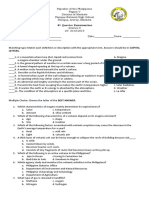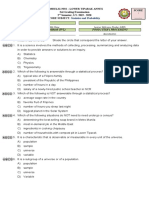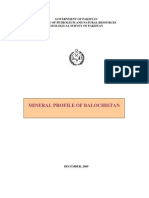0 ratings0% found this document useful (0 votes)
98 viewsFirst Quarter Exam in Science 10
First Quarter Exam in Science 10
Uploaded by
JohnRommelMoradoThis document provides a summary of a science exam for 10th grade students covering topics in geology and plate tectonics. The exam includes multiple choice and true/false questions testing knowledge of concepts like plate boundaries, the structure of the Earth's interior, seismic waves, plate tectonics theory and evidence supporting continental drift. It provides the student's name, date, class information and asks them to choose the correct answer for 44 multiple choice questions.
Copyright:
© All Rights Reserved
Available Formats
Download as DOCX, PDF, TXT or read online from Scribd
First Quarter Exam in Science 10
First Quarter Exam in Science 10
Uploaded by
JohnRommelMorado0 ratings0% found this document useful (0 votes)
98 views3 pagesThis document provides a summary of a science exam for 10th grade students covering topics in geology and plate tectonics. The exam includes multiple choice and true/false questions testing knowledge of concepts like plate boundaries, the structure of the Earth's interior, seismic waves, plate tectonics theory and evidence supporting continental drift. It provides the student's name, date, class information and asks them to choose the correct answer for 44 multiple choice questions.
Original Description:
Science
Original Title
2019 exam
Copyright
© © All Rights Reserved
Available Formats
DOCX, PDF, TXT or read online from Scribd
Share this document
Did you find this document useful?
Is this content inappropriate?
This document provides a summary of a science exam for 10th grade students covering topics in geology and plate tectonics. The exam includes multiple choice and true/false questions testing knowledge of concepts like plate boundaries, the structure of the Earth's interior, seismic waves, plate tectonics theory and evidence supporting continental drift. It provides the student's name, date, class information and asks them to choose the correct answer for 44 multiple choice questions.
Copyright:
© All Rights Reserved
Available Formats
Download as DOCX, PDF, TXT or read online from Scribd
Download as docx, pdf, or txt
0 ratings0% found this document useful (0 votes)
98 views3 pagesFirst Quarter Exam in Science 10
First Quarter Exam in Science 10
Uploaded by
JohnRommelMoradoThis document provides a summary of a science exam for 10th grade students covering topics in geology and plate tectonics. The exam includes multiple choice and true/false questions testing knowledge of concepts like plate boundaries, the structure of the Earth's interior, seismic waves, plate tectonics theory and evidence supporting continental drift. It provides the student's name, date, class information and asks them to choose the correct answer for 44 multiple choice questions.
Copyright:
© All Rights Reserved
Available Formats
Download as DOCX, PDF, TXT or read online from Scribd
Download as docx, pdf, or txt
You are on page 1of 3
First Quarter Exam In Science 10
August 08-09, 2019
Name: ____________________ Date: __________
Year & Section: _____________ Rating: _________
TEST I: Multiple Choice. Choose the letter of the correct answer.
1. If you visit a place in the Pacific known to be along converging plates, which of these should you not expect to see?
a. active volcanoes b. mountain ranges c. rift valleys d. volcanic islands
2. You are an oceanographer and want to map the ocean floor on the east coast of the Philippines. As you do your
study, you notice that there is a portion in the ocean floor which is relatively much deeper than the rest. What most
likely is that deeper part?
a. linear sea b. oceanic ridge c. rift valley d. trench
3. What do you expect to find at a mid-ocean ridge?
a. relatively young rocks c. thick accumulation sediments
b. reverse faults d. very ancient rocks
4. What plate boundary is formed between the Philippine plate and the Eurasian plate?
a. convergent b. divergent c. reverse fault d. transform fault
5. Which of these is false about lithospheric plates?
a. have the same thickness everywhere c. include the crust and upper mantle
b. thickest in the mountain regions d. vary in thickness
6. _____ is a thin part of the Earth’s Crust located under the oceans.
a. continental Crust b. oceanic Crust c. convergent boundary d. divergent boundary
7. ____ is a concentration of heat in the mantle capable of creating magma.
a. fault b. fracture c. Geology d. hotspot
8. Mountains formed in part by igneous activity associated with subduction of oceanic lithosphere beneath the
continent is called?
a. continental volcanic arc c. convergent boundary
b. continental crust d. divergent boundary
9. A boundary in which two plates move toward each other, causing one of the slabs of the lithosphere to subduct
beneath an overriding plate.
a. continental volcanic arc c. convergent boundary
b. continental crust d. divergent boundary
10. The outer portion of the Earth is called?
a. crust b. fault c. magma d. rocks
11. The thick part of the Earth’s crust not located under the oceans is called?
a. continental Crust b. oceanic Crust c. convergent boundary d. divergent boundary
12. It is a region where the crustal plates are moving apart is called?
a. continental crust b. oceanic crust c. divergent boundary d. mid-ocean ridge
13. Vibration of Earth due to rapid release of energy is k own as?
a. earthquake b. fault c. fracture d. subduction
14. The science that studies Earth is?
a. Geology b. Chemistry c. Biology d. Astronomy
15. A mass of molten rock form from a dept, including dissolved gases and crystals is known as?
a. Plate b. Crust c. Rocks d. Magma
16. A continuous mass of land with long with and height on the ocean floor is
a. Plate tectonics b. Primary wave c. Secondary wave d. Trench
17. Rigid sections of the lithosphere that moves as a unit is known as?
a. Plate b. Magma c. Hotspot d. rocks
18. A theory which suggests that Earth’s crust is made up of plates that interact in various ways, thus producing
earthquakes, mountains, volcanoes and other geologic feature.
a. Plate tectonics b. Subduction c. Volcanic arc d. Transform fault boundary
19. The first type of seismic wave to be recorded in a seismic station is?
a. Primary wave b. Secondary wave c. Seismogram d. Subduction
20. _____ are consolidated mixture of minerals.
a. Rocks b. Geology c. Fracture d. Fault
21. A record made by a seismograph is called
a. Subduction b. Seismogram c. Trench d. Volcanic arc
22. An event in which a slab of rock thrusts into the mantle is known as?
a. Subduction b. Seismogram c. Trench d. Volcanic arc
23. A boundary produced when two plates slide past each other is?
a. Volcanic arc b. Divergent boundary c. Convergent boundary d. Rocks
24. A depression in the sea floor produced by subduction process is _____.
a. Rocks b. Trench c. Rocks d. Boundary
25. A chain of volcanoes that develop parallel to a trench is _____.
a. Volcanic arc b. Volcanic trench c. Volcanism d. Volcanology
26. What makes up the lithosphere?
a. Continental Crust c. Upper mantle
b. Crust and upper mantle d. Oceanic crust and continental crust
27. The movement of the lithospheric plates is facilitated by a soft, weak and plastic lie layer. Which of the following
layers is described in the statement?
a. Asthenosphere b. Atmosphere c. Lithosphere d. Mantle
28. Miners dig into the Earth is search for precious rocks and minerals. In which layer is the deepest explorations made
by miners?
a. Crust b. Inner core c. Mantle d. Outer core
29. How do you compare the densities of the Earth’s crust, mantle, and core?
a. The mantle is less dense than the core but denser than the crust.
b. the mantle is less dense than both the core and the crust.
c. the mantle is denser than the core but less dense than the crust.
d. the mantle is denser than both the core and the crust.
30. If you are a cartographer, what will give you an idea that the continents were once joined?
a. Ocean depth c. Shape of the continents
b. Position of the south pole d. Size of the Atlantic Ocean
31. A new seafloor is formed at the mid-ocean ridge, the old sea floor farthest from the ridge is destroyed. Which of
the stated processes describes how the oceanic crust plunges into the Earth and destroyed at the mantle?
a. Convection b. Construction c. Diversion d. Subduction
32. _____ are mechanical vibrations that occur inside the Earth along fault lines caused by the breakage of rocks.
a. Seismic waves b. Ultimate waves c. Sonic waves d. Lower waves
33. _____ is the most abundant element in the Earth’s crust.
a. Silicon b. Hydrogen c. Potassium d. Oxygen
34. What materials make up the inner core?
a. Iron and nickel b. oxygen and hydrogen c. Sodium and iron d. Aluminum and calcium
35. Soft, weak upper portion of the mantle where the lithospheric plates float and move around is?
a. Asthenosphere b. lithosphere c. Plasticity d. Subduction
36. A boundary that separates the crust and the mantle?
a. Mohorovicic Discontinuity c. Gutenberg Discontinuity
b. Plate tectonics d. Sea floor spreading
37. _____ is the branch of Geology that deals with the movements and shape the Earth’s crust.
a. Subduction b. Tectonics c. Asthenosphere d. Plasticity
38. If Glossopteris fossils were found in Antarctica, what does this indicate about the climate of this continent before?
a. It proves that the Antarctica had tropical climate before
b. It proves that the continent before are separated from each other
c. It tells us that the Antarctica is found away from the equator before
d. It tells that the position of the continents before are away from each other
39. ______are also called compressional waves which ca travel through solids, liquids, and gas.
a. Primary waves b. Love waves c. Raleigh waves d. Secondary waves
40. This sub-type of surface wave travels along the surface of the Earth from the point directly above the epicenter
and the most damaging type is?
a. Primary waves b. Love waves c. Raleigh waves d. Secondary waves
41. What is not TRUE about the Earth’s Mantle
a. It is the Middle layer of the Earth c. Makes most of the Earth’s volume and mass
c. Contains the elements silicon and iron d. It is less dense than the crust
42. When two plates collide, the oceanic crust usually subducts beneath the continental crust because it is:
a. Denser than the continental crust c. Thicker than the continental crust
b. Less dense than the continental crust d. Thinner than the continental crust
43. What are the two types of seismic waves/
a. Body wave and Rayleigh wave c. Surface wave and Body wave
b. love wave and Rayleigh wave d. Primary wave and Secondary wave
44. most of the shaking felt from an Earthquake is due to what type of surface wave?
a. Primary wave b. Rayleigh wave c. Body wave d. Love wave
45. Which of the following is Not a Geologic process that occurs along convergent boundaries?
a. Earthquakes b. Tornado c. Mountain building d. Volcanism
46. These are large tectonic plates Except?
a. Antarctic plate b. Indian plate c. Pacific plate d. African plate
47. Which of these terms is least related to earthquakes?
a. Trench b. Lava c. Fault d. Epicenter
48. This is the Japanese term for “harbor wave” and is a series of ocean waves with very long wavelengths cause by a
large-scale disturbance of the ocean.
a. Tsunami b. boundary c. Spreading d. Subduction
49. A boundary in which two plates move toward each other, causing one of the slabs of the lithosphere to subduct
beneath an overriding plate.
a. continental volcanic arc c. convergent boundary
b. continental crust d. divergent boundary
50. Vibration of Earth due to rapid release of energy is k own as?
a. earthquake b. fault c. fracture d. subduction
Prepared by:
JOHN ROMMEL R. MORADO
Subject Teacher
Noted:
ESTER R. SANTILLAN
Principal I
You might also like
- Assignment 02 (BUSN 300)Document6 pagesAssignment 02 (BUSN 300)Iqtidar KhanNo ratings yet
- Earth and Space Direction: Encircle The Letter of The Best AnswerDocument6 pagesEarth and Space Direction: Encircle The Letter of The Best AnswerJesmar Quirino TutingNo ratings yet
- Science q2Document8 pagesScience q2Ma Lourdez BayanNo ratings yet
- SOCIAL STUDIES Grade 10 Worksheet # 2 2020Document2 pagesSOCIAL STUDIES Grade 10 Worksheet # 2 2020kamar findlayNo ratings yet
- 1lyrucudo - 3rd Quarter (Preliminary Exam)Document4 pages1lyrucudo - 3rd Quarter (Preliminary Exam)Rolando AloguinNo ratings yet
- Music Art Grade 9 TestDocument4 pagesMusic Art Grade 9 TestJC Gonzaga100% (1)
- Similar Triangles (NO ANSWER KEY)Document5 pagesSimilar Triangles (NO ANSWER KEY)Joel TabaniagNo ratings yet
- First Periodical Test - Math 10Document2 pagesFirst Periodical Test - Math 10Ai RenNo ratings yet
- 1ST Quarter Exm Mapeh 9Document4 pages1ST Quarter Exm Mapeh 9Jesabe Taon100% (1)
- Final - Comfund Sy 14-15Document5 pagesFinal - Comfund Sy 14-15Jason YaraNo ratings yet
- Grade 10 Quarterly Examination Q2Document8 pagesGrade 10 Quarterly Examination Q2Cathy MoronioNo ratings yet
- 2ND Quarter Test - Mapeh 9Document4 pages2ND Quarter Test - Mapeh 9Thel Padiz DistritoNo ratings yet
- English 10Document2 pagesEnglish 10Buddy Roy IbañezNo ratings yet
- Science10 Q4 Week-3-BiomoleculesDocument7 pagesScience10 Q4 Week-3-BiomoleculesMaskter ArcheryNo ratings yet
- English10 PreTestDocument4 pagesEnglish10 PreTestJoshua ReyesNo ratings yet
- (Final) Ict TestDocument10 pages(Final) Ict TestLei Xandra MeiNo ratings yet
- PT G10 MapehDocument5 pagesPT G10 MapehSeth Xaviery LofrancoNo ratings yet
- 3rd Quarter Exam Jan 2019Document19 pages3rd Quarter Exam Jan 2019GABRIEL CABANSAGNo ratings yet
- 2nd Quarterly Exam Ict Specialization 10Document2 pages2nd Quarterly Exam Ict Specialization 10heidee carpioNo ratings yet
- 2nd Quarterr Summative Test Grade 10Document4 pages2nd Quarterr Summative Test Grade 10HAIDEENo ratings yet
- Explaining OxymoronsDocument2 pagesExplaining OxymoronsManuel J. Degyan100% (1)
- Tle Ict Grade 10Document1 pageTle Ict Grade 10Lawrence PaladinNo ratings yet
- LAS Q3math8 - Q3 - wk2 - Melano For SubmissionDocument12 pagesLAS Q3math8 - Q3 - wk2 - Melano For SubmissionFlorame Algarme MelanoNo ratings yet
- Tambulig National High School Tuluan Extension First Quarter Examination English 9Document3 pagesTambulig National High School Tuluan Extension First Quarter Examination English 9JollyGay Tautoan LadoresNo ratings yet
- Learning Activity Sheet: 4 QuarterDocument21 pagesLearning Activity Sheet: 4 QuarterSelena ThaliaNo ratings yet
- Lesson 3.1 Direct Variations Key PointsDocument3 pagesLesson 3.1 Direct Variations Key PointsMidoriya IzukuNo ratings yet
- English 8aDocument3 pagesEnglish 8aBrylle Jairus Lacamen100% (1)
- 1st QTR Periodic Exam 2022-2023Document4 pages1st QTR Periodic Exam 2022-2023Dizon MRaineNo ratings yet
- Third Periodical Test Grade 8 FinaleDocument6 pagesThird Periodical Test Grade 8 FinaleRosefa RendonNo ratings yet
- First Periodical Test in Science Grade 7Document2 pagesFirst Periodical Test in Science Grade 7JOHANNES MAE UNGRIANo ratings yet
- 1st Periodical Test Grade 9Document4 pages1st Periodical Test Grade 9Adrian FromPHNo ratings yet
- 2nd Quarter English 10Document3 pages2nd Quarter English 10Joy Baldomaro AlimanNo ratings yet
- 3rd PT 22-23Document3 pages3rd PT 22-23Faye LouraneNo ratings yet
- English 10 (Week 2) (Vibal)Document14 pagesEnglish 10 (Week 2) (Vibal)Jubylyn AficialNo ratings yet
- Letters. - 1. Is A Mountain Where Lava (Hot, Liquid Rock) Comes FromDocument3 pagesLetters. - 1. Is A Mountain Where Lava (Hot, Liquid Rock) Comes FromKristine Ibarreta-JazulNo ratings yet
- 2nd Quarter G8. ExamDocument3 pages2nd Quarter G8. ExamMae Ann Miralles PiorqueNo ratings yet
- Atmosphere QuizDocument1 pageAtmosphere QuizDanielle StowaterNo ratings yet
- Summative ROBOTICSDocument5 pagesSummative ROBOTICSHasmin lipang eniolaNo ratings yet
- Second Periodical Examination in Grade 7 Science NAME: - SCORE: - YEAR & SECTION: - Parents' SignatureDocument6 pagesSecond Periodical Examination in Grade 7 Science NAME: - SCORE: - YEAR & SECTION: - Parents' SignatureelynNo ratings yet
- Practice Problems Ch. 9 Unemployment and InflationDocument6 pagesPractice Problems Ch. 9 Unemployment and InflationElizavetaNo ratings yet
- Stat & Prob 11 Exam 3rd FINALDocument6 pagesStat & Prob 11 Exam 3rd FINALBill VillonNo ratings yet
- S8 Midterm AssessmentDocument7 pagesS8 Midterm AssessmentRutchie LasqueNo ratings yet
- English 9 Test Questionaire 2nd QuarterDocument14 pagesEnglish 9 Test Questionaire 2nd QuarterHarvey jan CarbonellNo ratings yet
- Grade 7 Second Periodical ExaminationDocument5 pagesGrade 7 Second Periodical ExaminationGenuine WadwasinNo ratings yet
- T.L.E 7 Computer 3RD Quarter ExamDocument4 pagesT.L.E 7 Computer 3RD Quarter ExamLiza TradioNo ratings yet
- G10Mapeh Exam First QuaterDocument8 pagesG10Mapeh Exam First QuaterJonas LamcisNo ratings yet
- Fourth PERIODIC TEST Math 9 - 2022 2023Document5 pagesFourth PERIODIC TEST Math 9 - 2022 2023Jonathan OlegarioNo ratings yet
- Grade 8 EnglishDocument2 pagesGrade 8 EnglishMaria Farah PagaduanNo ratings yet
- Department of Education: Republic of The PhilippinesDocument3 pagesDepartment of Education: Republic of The PhilippinesKayelle Clyde LavarejosNo ratings yet
- 2nd Periodical Test in Math G10 19-20Document3 pages2nd Periodical Test in Math G10 19-20Dom BelloNo ratings yet
- Grade 9 2nd Periodical TestDocument2 pagesGrade 9 2nd Periodical TestFishTea Coolerang JaowahNo ratings yet
- Eng10-Quarter Test 1qDocument4 pagesEng10-Quarter Test 1qRis Leahcim YohomalcNo ratings yet
- TLE - Information and Communication Technology Tle 8 First Quarterly AssessmentDocument4 pagesTLE - Information and Communication Technology Tle 8 First Quarterly AssessmentVincent RivacNo ratings yet
- 1st Quarter Test in Grade 7 Science 2016Document4 pages1st Quarter Test in Grade 7 Science 2016gerald quijanoNo ratings yet
- Lesson 2 (Trigonometric Functions of Angles)Document4 pagesLesson 2 (Trigonometric Functions of Angles)5am. exeNo ratings yet
- 2nd Periodical Exam (g9)Document6 pages2nd Periodical Exam (g9)Elmar Dela TorreNo ratings yet
- Q 2 Week 1-3 Summative Test Science 8Document3 pagesQ 2 Week 1-3 Summative Test Science 8EDWIN DUMOPOY100% (1)
- 2d Quiz KeyDocument5 pages2d Quiz KeySheryl Nishmae Bernardo Santos100% (1)
- 1st Period Sci. 10 19Document4 pages1st Period Sci. 10 19Eivol Kimoy ÖNo ratings yet
- Pretest Science10Document3 pagesPretest Science10Washima Bentulina SabtalNo ratings yet
- Department of Education: Republic of The PhilippinesDocument15 pagesDepartment of Education: Republic of The PhilippinesJohnRommelMoradoNo ratings yet
- (District) (School) : Summary of Teacher'S RatingDocument2 pages(District) (School) : Summary of Teacher'S RatingJohnRommelMoradoNo ratings yet
- Examples of Research QuestionsDocument2 pagesExamples of Research QuestionsJohnRommelMoradoNo ratings yet
- Department of Education: Republic of The PhilippinesDocument3 pagesDepartment of Education: Republic of The PhilippinesJohnRommelMorado60% (5)
- Department of Education: Republic of The PhilippinesDocument1 pageDepartment of Education: Republic of The PhilippinesJohnRommelMoradoNo ratings yet
- Mirror Image Lesson PlanDocument3 pagesMirror Image Lesson PlanJohnRommelMoradoNo ratings yet
- Periodic Exam 2019Document28 pagesPeriodic Exam 2019JohnRommelMorado100% (1)
- Scienece 10 1st PeriodicDocument1 pageScienece 10 1st PeriodicJohnRommelMoradoNo ratings yet
- Lesson Plan (Cot)Document10 pagesLesson Plan (Cot)JohnRommelMoradoNo ratings yet
- Palaeogeography Around The Harappan Port of Lothal, Gujarat, Western IndiaDocument8 pagesPalaeogeography Around The Harappan Port of Lothal, Gujarat, Western IndiaPaper BarrackNo ratings yet
- Sifat Dinamis Struktur Bumi: Pengetahuan GempaDocument18 pagesSifat Dinamis Struktur Bumi: Pengetahuan GempafebrinaNo ratings yet
- Ore Genesis WikipediaDocument8 pagesOre Genesis WikipediaAnkurKumarNo ratings yet
- Study Guide Earth and Life Science Grade 11: Uccp Magill Memorial School IncorporatedDocument20 pagesStudy Guide Earth and Life Science Grade 11: Uccp Magill Memorial School IncorporatedAngelyn MironesNo ratings yet
- Channel Stability RosgenDocument11 pagesChannel Stability RosgenJoseph NemeshNo ratings yet
- Mineral Profile of Baloch I StanDocument24 pagesMineral Profile of Baloch I StanOolasyar Khattak50% (2)
- Sanjiv Shah Underground Excavations at CHEPDocument77 pagesSanjiv Shah Underground Excavations at CHEPSaphal LamichhaneNo ratings yet
- Faryad PTT ConstraintDocument18 pagesFaryad PTT ConstraintGhislainarrowNo ratings yet
- Silica: World Production and ReservesDocument8 pagesSilica: World Production and ReservesVellia AzoraNo ratings yet
- Kitui-Patricia Mbathe Malonza-Hydro-ReportDocument62 pagesKitui-Patricia Mbathe Malonza-Hydro-Reportpablo studiosNo ratings yet
- Kimberlit ES: Wajid Rehman & NoorullahDocument20 pagesKimberlit ES: Wajid Rehman & Noorullahsaif 2457No ratings yet
- Grad School Personal StatementDocument18 pagesGrad School Personal Statementvacc85100% (2)
- Azzouni Sekkal1987Document12 pagesAzzouni Sekkal1987OmatoukNo ratings yet
- For Other Uses, See and .: Tsunami (Disambiguation) Tidal WaveDocument4 pagesFor Other Uses, See and .: Tsunami (Disambiguation) Tidal WavevenothNo ratings yet
- The Development of Hazard Plans at Kestrel Mine: Research OnlineDocument11 pagesThe Development of Hazard Plans at Kestrel Mine: Research Onlinekatta_sridharNo ratings yet
- Formation of Sedimentary Rock PowerPointDocument15 pagesFormation of Sedimentary Rock PowerPointDaniel MalicNo ratings yet
- Mata Kuliah Mikropaleontologi UirDocument44 pagesMata Kuliah Mikropaleontologi UirFirda FitriyaniNo ratings yet
- NI 43 101 Stephens Lake MB Final 10 Jan 11Document45 pagesNI 43 101 Stephens Lake MB Final 10 Jan 11Ade PrayudaNo ratings yet
- 7 - Omission and Repetition PDFDocument5 pages7 - Omission and Repetition PDFRonuelGreenidgeNo ratings yet
- Chapter 15 - Island - ArcsDocument50 pagesChapter 15 - Island - ArcsJean D. MARIN PADILLLA100% (1)
- Y8 - Earth Science - Crystal Cooling - PRAC - TEACHER NOTESDocument4 pagesY8 - Earth Science - Crystal Cooling - PRAC - TEACHER NOTESAtifur KhanNo ratings yet
- A Tectonic PlateDocument3 pagesA Tectonic PlateRamona BaculinaoNo ratings yet
- The Mechanical Earth Model Concept and Its Application To High-Risk Well Construction ProjectsDocument13 pagesThe Mechanical Earth Model Concept and Its Application To High-Risk Well Construction ProjectsWaleed EjazNo ratings yet
- Baron, G Ungemach - 1981 - European Geothermal Drilling Experience - Problem Areas and Case StudiesDocument24 pagesBaron, G Ungemach - 1981 - European Geothermal Drilling Experience - Problem Areas and Case StudiesCATALINA MEDRANONo ratings yet
- AVO Screening in Frontier Basins An Example From The Gulf of Papua, Papua New GuineaDocument5 pagesAVO Screening in Frontier Basins An Example From The Gulf of Papua, Papua New Guineageofun86No ratings yet
- The Maharaja Sayajirao University of Baroda: Faculty of Sclenoe Master of SciencDocument1 pageThe Maharaja Sayajirao University of Baroda: Faculty of Sclenoe Master of Sciencavinash goswamiNo ratings yet
- Formation Evaluation of Reservoir, Khabbaz Oil Field, NE Iraq PDFDocument183 pagesFormation Evaluation of Reservoir, Khabbaz Oil Field, NE Iraq PDFFarida AwwaliyahNo ratings yet
- Floresta and PajaDocument4 pagesFloresta and PajaJorge Åndres Tavera ReyesNo ratings yet
- 8th Grade World Geography Lesson Plans Week 3Document2 pages8th Grade World Geography Lesson Plans Week 3christopher salberNo ratings yet
- Sonic (DT) Log: Well Logging (Pe413)Document7 pagesSonic (DT) Log: Well Logging (Pe413)Ramy MaamounNo ratings yet

